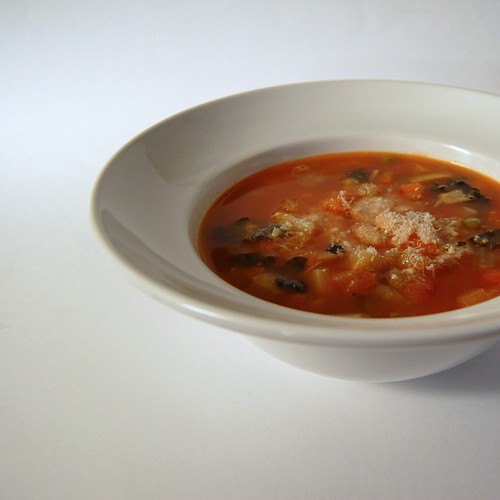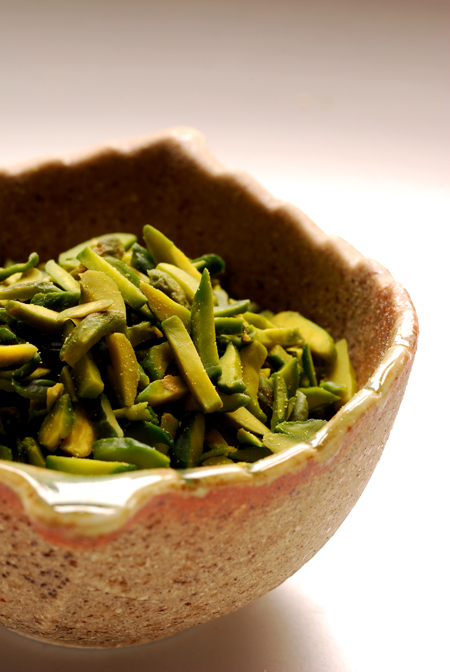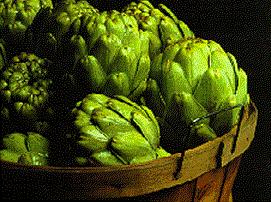Lately I've copped a bit of (mostly good-natured) flak about the crunchy nature of most of my blends. Fair call, and being Australian I am all for the sort of well-meaning stirring we often charmingly refer to as "shit-giving", since being vile to each other and heaping insult and deprecation on our close friends and loved ones proved a valid means of overcoming the torpid emotional stifling and suppression that came with the English part of our foundation. We're not quite so comfortable with declarations of love as we are with personal insult. So when you meet an Australian, and when they first call you a bad word, then you know they like you a lot and have accepted you as a friend - just so as you know, OK? You silly bastard.
So anyway, yes, my take on things nutritional is unapologetically a bit on the crunchy side. Like a hippie into top-fuel drag racing though, I also wholeheartedly approve of Nigella Lawson's ridiculously consumption-oriented antics in the kitchen in that her message at heart is about joy and love and the shortness of life. She just expresses it differently from the way I do, is all.
An oft-commented-upon phenomenon when people begin a blended Tube Food journey is the dawning of awareness of food in a whole new way - whether we are blending for ourselves or someone in our care. In fact, it especially applies to parents of small children. What happens, by simple virtue of putting stuff into a see-through container and turning it effectively into stomach contents minus the lumps and digestive juices is that we see and smell what a whole meal is really like, down at 'gut' level. Of course there's the informational approach as well to do our heads in; just in case the blender wasn't illustrative enough. We read the ingredients on a can of formula, are perhaps a little horrified as we fully understand what it is humans are being asked to subsist on, solely, for the foreseeable future. Then when we go to replace that with a 'regular' store-bought sort of pre-packaged meal (such as we'd happily eat at home), reading the ingredients and scrutinizing the caloric values and nutritional breakdowns gives us another pause for thought. So many unnatural chemicals, so much fat, sugar, salt, so highly denatured and processed...........but it's still OK because it isn't formula; that still makes it OK as Real Food doesn't it?
That, friends, is for each one of us to decide.
My last post here was all about choosing better over best, and why it's a sensible approach. I stand by it, as I stand by Nigella's genuine quest to enhance our enjoyment of all things foody. But my journey, and that of many tubies and tubie carers, takes a different path; one more akin to entering the food, to accepting the axiom "you are what you eat" as more than just a throwaway line. This runs the risk of being seen as very crunchy indeed.
We tubies tend to be an unwell lot on average, it must be said. I mean there are reasons we have tubes, it's not a lifestyle choice for most of us. And when you take the connection between nourishment and wellness, then it's hard to turn away from. The burden of such knowledge, that you can almost without any doubt make a huge difference on your spectrum of ill-health to good-health just by changing your diet, is a heavy one, unless acted upon with some grace. Admitting that our average diet is frankly an unsustainable horror and abomination to the planet and our health is hard. It means changing our ways. Facing up to things. Admitting we have been conned, perhaps.
But all too easily, steps on the road to this awareness can feel just so relentlessly negative, and this demotivates many of us. Such negativity is often cited as a reason to shy away from falling in with the crunchy brethren and settling for more of the 'regular' normative diet of Homo Microwavicus. I'm referring to the set of discoveries that those seeking information about food and health make very early on - that pretty much everything that you used to think of as 'food' gives you cancer, heart disease, diabetes, makes you obese, is addictive, messes with your mood and stunts your intelligence. Etcetera. It can seem like it's an all-or-nothing venture, either you become a sandal-wearing vegan self-sufficient organic solar power producer and join the ranks of the annoyingly self righteous or you just shy back from the enormity of the whole modern diet catastrophe and settle down to a big dish of nice consoling 'low-fat' chocolate and bacon icecream. I know many people are simply put off by the mention of a whole grain, an organic vegetable, a mung bean. And anyway, isn't it all like really hard work?
This last myth is the one I want to bust today. That using good whole foods is difficult, that *cooking* in itself is hard, takes loads of time, and is expensive. Baloney.
Double baloney if you have a good blender at your disposal. Many folks new to the idea of a blenderized diet start from the premise that food will need to be treated in very certain and specific ways to be safely used in a tube. Not so; in fact, quite the contrary. I found that getting to know my Vitamix was one of the most liberating things I'd ever experienced with food. Simply put - I can blend anything. Paradoxically, this makes it easy to just throw in some Carnation Instant Breakfast, skim milk powder, Cheerios and perhaps a Twinkie and be done with it. Just as easy is opening a can of formula, and the formula would be arguably better for you too. But the real possibilities such a blender opens up are awesome - if you're cooking a healthy meal for the family then that can go right in the blender too. How simple is that? Any food you can think of to eat in the whole world - you can blend it.
Maybe you've done a bit of reading, and been inspired to go down the local market and buy some bulk whole grains, or legumes. Maybe you live in a food desert and have to travel to get such things, so you stock up - all good. You've discovered that frozen vegetables are not only often better quality than 'fresh' from the supermarket but way cheaper too. Perhaps you've gotten word around with friends and decided that if you all pool together you can buy half a grass-fed organic cow, have it butchered, divided between you and put up in the freezer. These things all make crunchy so much cheaper than the cheapest junk food it's beyond belief. Rice and beans or any grains, chosen well, with a little bit of some good fats, some vegetables, maybe some animal parts or secretions, that's the foundations we're talking about. And if you only look at the adventure from a tube Food perspective, then the whole area of cooking becomes suddenly ten times easier. Why? Because it just doesn't matter how it looks, what it tastes like, or whether you cooked it totally 'right'. It's pretty much impossible to fail.
Crunchy really is just as quick as the alternative, but there's a catch - crunchy usually means waiting. Rice takes a little while to cook. Soaking beans is a really good idea, so you'll find yourself spending a whole 120 seconds (that's two minutes) getting out a bowl and some water the night before. Job's already half done then, you see. Inventions like rice cookers and slow cookers make it so amazingly simple and easy to prepare too. Grains, beans, vegetables, meats, whatever - in the crock. Set. Come back 3 or 4 hours later and blend. That was 15 minutes of your life, just spread over a morning or afternoon. And the rewards? You've spent less cash (if you've shopped or grown well and wisely), gotten tastier food, better nutrition, a sense of providing and accomplishment, and taken less time than wrangling a bunch of cans/jars/plastic packets, microwaves and other gear, plus you've been quite a bit kinder to the environment. But there are TWO extra benefits that come from this, neither of which seem obvious in the face of the other.
One, every step you make towards a more naturalistic and 'whole' crunchy approach to food makes every other step that more inviting, that bit more inspiring and easier, as you discover new sensations and flavours, and gain confidence. Of course, noticing great health improvements can be pretty motivating as well. But number two, opposite to this and just as important, you'll probably come to care far less about the occasional 'bad' food choice episode. You'll stop feeling such guilt at consuming a processed convenience or indulgent luxury food here and there. You'll recognize you're making a certain trade-off between your momentary sense of wellbeing (it was late, convenient, and it's a tasty treat for the family etc) and your desire to feed your tube or your tubie as healthfully as possible. Why? Because you'll have the satisfaction of knowing that all that other crunchy stuff you're doing is making up for such stuff. You can have your Nigella Lawson moments and buy the extravagantly enriched dark chocolate nibblies without overly worrying about the transnational corporation's probable use of child labour or the empty fat-forming calories because you'll have realised by now it's impossible to 100% avoid doing all harm all the time, and because your choices are, for the most part, very responsible ones. Importantly, that does something very profound to the food we eat (and the food we tube), I believe, or at least to how we assimilate it in ourselves.
How we feel about our food and tube food is just as important as the food itself, in my small and humble opinion. If it's a burden, if there's a sense of stress, and it all comes down to being a chore - and if we doubt its goodness and whether it's the 'right' thing, then we are doing ourselves a great disservice. Stress and worry are the biggest and most easily remedied influences on digestive health there are, and they're incredibly infectious. A carer's stress will translate to a tubie's distress, without a word said or a mention made. Just as if we're worrying about whether the processed comfort food we're eating is making us fatter and moving us ever closer to diabetes and a coronary before the age of 50 is more sure to make it so than being less worried, because the stress itself is bad for your heart and wreaks havoc with your digestion. The worry itself creates that great, terrible feedback loop of nihilism - the one that returns you to the sofa with the soda, the chemically-enhanced 1500 cal popcorn with 1000% of your rdi of sodium, and the triple-choc fudge.
Better really is so much better than best in all this too. Making a move in the crunchy direction not only makes further moves easier, but it makes 'retrograde' decisions less stressy too. And you'll find over time you make fewer of those processed convenience-food type choices anyway, but enjoy them all the more because of it.
Nigella's hardly the role model for crunchy healthful planet-loving sustainable foodiness, but she's got one thing nailed for sure - genuine enjoyment is at least half the picture.
And since you're reading this here, chances are very high you already know the broad benefits of the Crunchy, and the major horrors of the slick, corporatized consumerist Smooth. So your choice is fairly (or perhaps unfairly) clear - embrace a bit of a crunchwards direction in your food and tube life, or be prepared for the pressure and stress of your resistance to make you feel worse and more disconnected as time goes on.
I believe in the end that natural selection-type pressures will prevail over our dietary and lifestyle mistakes anyway. We will all die too, of course; so in the light of this mortal reminder the only real question is this:
How smooth do we want our change into the crunchy future to be?
.
.


























